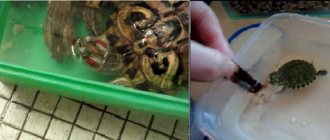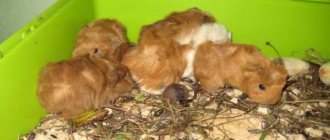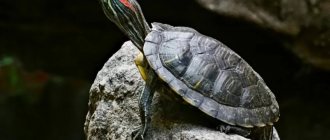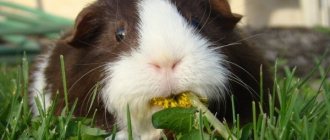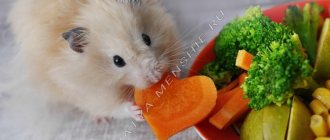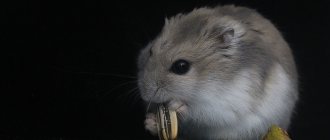Aquatic ornamental turtles are frequent inhabitants of home aquariums. These cute reptiles are loved by children and adults alike. In order for a turtle to live a long and fulfilling life in a closed tank, you need to create appropriate living conditions for it and pay special attention to the correct diet.
In the article we will look at popular brands of complete food and treats for aquatic turtles, how many times a day, at what time and how to feed them correctly, whether turtles need mineral and vitamin supplements, differences in the diet of adult and small pets, and also depending on the species turtles.
What to feed at home?
Under natural conditions it is an omnivorous predator. Red-eared turtles eat plant and animal foods with equal appetite. In nature, they hunt for small fish, snails, fry, crustaceans, and plankton. But for the strength and growth of the shell, the substances contained in food of animal origin are not enough, therefore plant food is definitely needed, from which the body receives vitamins and calcium.
The peculiarity of these turtles is that they eat in water, although it is quite possible to train them to eat on an island equipped in an aquarium, but this will take time and patience.
It is necessary to accustom it, since constant feeding in water leads to the fact that uneaten food quickly deteriorates, and an unpleasant odor begins to emanate from the aquarium.
To teach a turtle to take food on land, food is first placed near the very edge of the water. A hungry reptile will definitely take food. Then she is gradually accustomed to taking food from a small saucer into which a little water is poured.
If you wish, you can take the turtle out and feed it in a small plastic bowl of water. In this case, the water in the aquarium will remain clean for the longest time.
Pond slider
Not all turtles are the same
Turtles belong to the class of reptiles, or reptiles (although here, given the presence of a hard, inflexible shell, this name does not seem entirely appropriate). These are ancient animals that arose more than 200 million years ago. The most important difference between turtles and other reptiles is the presence of a protective cover, a shell that protects the animal from external threats.
All turtles are not only divided into 2 large categories: land and sea. In addition, they differ in size and habitat.
There are 2 main suborders, divided according to the type of way they hide their head in their shell:
- cryptocervical - place the head inside the shell in the shape of the letter S;
- side-necked - hide the head towards the side paw.
Based on habitat they are divided into:
- marine - live in bodies of salt water;
- terrestrial - live either on land or in fresh waters.
Accordingly, terrestrials are divided into land and freshwater.
In total there are more than 300 species, which form about 14 families.
Learn more about trionics and vulture turtles.
Based on size , land turtles are divided into:
- large ones - the elephant tortoise (Galapagos), reaching a length of 2 meters and a weight of 400 kg; leopard (panther) tortoise - 1 meter in height and 50 kg in weight; Seychelles giant tortoise - 1 meter in length and up to 120 kg in weight, etc.;
- small ones - Cape speckled (the smallest in the world), reaching 10 cm in length and weighing a maximum of 200 g; Central Asian - height up to 20 cm, weight up to 10 kg; Egyptian turtle - up to 10 cm in length, weight up to 6 kg, etc.
Freshwater ones are:
- medium - caiman species (length up to 1 meter, weight up to 30 kg), red-eared (up to 40 cm in length, weight up to 20 kg), European swamp (40 cm in length and weight up to 15 kg);
- small ones - painted turtle (up to 15 cm in length, weight up to 4 kg), black marsh turtle (up to 18 cm in length, weight up to 4 kg), Cagliz card (length up to 18 cm, weight up to 3 kg), etc.
Marine ones are also divided into large and small - in total there are more than 70 species.
Did you know? Modern research debunks the myth about the slowness of turtles: it has been proven that marine species can move at speeds of up to 40 km/h - considering their size, this is quite a high speed. The speed of movement directly depends on the weight of the shell: the heavier it is, the slower the animal moves.
By type of food they are divided into:
- carnivorous (they need up to 90% of food of animal origin) - this includes almost all aquatic animals (especially young ones); it is noteworthy that with age, predatory individuals can become omnivores;
- omnivores (50% plants and 50% animal food) - both land and sea;
- herbivores - (up to 90% plant food) - some types of land turtles.
Plant food for red-eared turtles
Remember that the older your pet is, the larger part of the diet should be plant food. Young animals always prefer food of animal origin; they can completely refuse plant food within a few days.
List of what red-eared turtles eat from plant foods :
- Vegetables - you can give cucumbers, tomatoes, zucchini, sweet peppers, pumpkin, radishes, beets. Most turtles don't really like carrots. They also give celery, broccoli, and white cabbage (in small quantities). All these vegetables must be raw, without traces of rot or mold. You can’t give boiled ones, they no longer contain anything useful for the turtle’s body. Onions, radishes, rhubarb, and eggplants are strictly prohibited.
- Fruits and berries - apples, pears, bananas, plums, peaches, mangoes, tangerines, oranges, apricots, melons, strawberries. They must be damp and without signs of rot, mold, or worms inside. They are cut into small pieces before feeding. Citrus peels and berries with seeds should not be given.
- Mushrooms – turtles can be offered pieces of champignons, russula, boletus, but not more than once a week.
- Grass – these reptiles love the leaves and flowers of dandelions, plantain, clover, coltsfoot. You can bring them lawn grass. You need to collect greens for turtles only in pedestrian squares, parks, or, in extreme cases, on streets with private houses where few cars drive. It is strictly forbidden to bring greens collected near large roads and railway tracks. In winter, oats should be sprouted in cups for the turtle; when the greens grow to a height of 5 cm or more, they are cut and fed. For germination, you will need to stock up on soil and sand in advance in the summer; you can also grow oats in sawdust.
- Aquarium plants – duckweed, spirogyra, water beetle, and pond algae are suitable for turtles. These reptiles will not allow plants to grow luxuriantly, because they quickly eat them. You cannot plant elodea, its juice is poisonous to the red-eared turtle.
Spirogyra
Is there a difference between nutrition in winter, spring, summer, autumn
What do turtles eat at home, and is there a fundamental difference in their diet at different times of the year? Experts answer this question differently. However, everyone agrees that turtles, like other animals, are able to sense changes in seasons and weather, which affects their diet. Thus, herbivorous and omnivorous turtles in the summer prefer juicy fresh greens and vegetables, while in the cold months they prefer frozen or dried vegetables and soaked hay.
As for the volume of food consumed at different times of the year, the following trend has been noticed: in summer turtles eat more often, but in smaller quantities, but in winter - less often, but more.
What animal foods can you feed?
They should make up at least 70% of the turtle's daily diet. With age, their number decreases slightly.
Animal feed:
- only meat you can give is beef, rabbit, chicken, and turkey. Lamb and pork are not allowed. The diet must include chicken by-products: stomach, liver, heart. Meat can be given raw or cooked. Before feeding, it is finely chopped. You cannot feed raw meat constantly, otherwise the turtle will develop rickets. You need to alternate between cooked and raw.
- Fish and seafood - pollock, hake, cod, blue whiting, navaga, perch and carp are suitable. The fish is cut into small pieces along with small bones. Large rib bones are removed. Before feeding, raw fish must be placed in hot water for a couple of minutes to neutralize the enzyme thiaminase, which is harmful to turtles. Without such pre-treatment, you can serve a “sea cocktail” in its raw form - pieces of octopus, squid, shrimp. Fish for turtles is food, so they do not get along in the same aquarium: the fish will be caught and eaten.
- Insects – you can buy grasshoppers and mealworms at the pet store. Also in the diet there should be gammarus, they periodically give daphnia, turning off the filter for 15 minutes during such feeding. You cannot give beetles caught on the street. You should also not feed cockroaches; they may already be poisoned.
Seafood
Diet of an adult turtle and small pets
The diet of an aquatic turtle should be combined - natural food combined with artificial food. Let's look at what foods can and cannot be given to aquarium reptiles.
Useful and harmful natural products for aquatic turtles:
- You can give low-fat river fish in crushed form with chopped bones. You should not feed turtles bony and fatty fish.
- You can feed live gammarus and small crustaceans.
- Shrimp and crabs are allowed to be fed raw.
- You should not feed turtles squid, although they love them very much.
- It is strictly forbidden to give reptiles the meat of terrestrial animals and factory-made meat products (sausage, canned food, etc.). The digestive system of reptiles does not digest such food.
- Occasionally you can treat your turtle to pieces of beef heart and liver. These foods provide the body with vitamin A.
- It is allowed to feed the reptile with food mice and frogs.
- From natural plant foods, turtles can be given carrots, lettuce, apple pulp, greens, sprouted oats and barley.
- Non-poisonous meadow plants, as well as algae and some types of aquatic plants can be introduced into the diet.
- Pieces of pear, watermelon, melon, banana, apricot and raspberry are served in limited quantities.
- You cannot give turtles citrus fruits, nuts, soybeans, beans, cabbage, bread, flour products, cereals, fish waste, dairy products, and chicken eggs.
- Foods high in phosphorus, strumogenic substances and oxalates are harmful to reptiles.
- With pleasure and benefit, turtles eat various insects and larvae living in the water. They can be fed barnacles, bloodworms, locusts, crickets, fly larvae, earthworms and moths. The insect must first be decapitated. Can be given dried, frozen, or live.
- Live and thawed mollusks, land snails, ampularia, marises, etc. are well absorbed by the reptile body. But it is better not to treat the turtle to slugs without shells.
Feeding with artificial feed
This is the best choice for busy people who do not have time to prepare a diet for a turtle or cut up food. Pet stores have special balanced food for red-eared turtles in tablets, granules, flakes and capsules. In fact, they are food for fish, but improved taking into account the needs of the reptile's body.
There are times when a turtle does not like the pungent smell of such food; it turns away from artificial food, but after a while it still gets used to it. Its main disadvantage is the high price.
Types of red-eared turtles, sizes and features
The red-eared slider includes three subspecies, which have their own morphological (appearance) characteristics.
The first representative of this species is
Trachemys scripta scripta . Its peculiarity lies in the yellow color of the stripes on the muzzle (transitioning into a large yellow postorbital spot), which connect on the neck. There are yellow stripes on the lateral (costal) scutes of the dorsal carapace (carapace), and yellow spots on the anterior scutes of the ventral carapace (plastron )
. In size it reaches up to 27 cm.
The second representative, more familiar to all of us, is
Trachemys scripta elegans . Its postorbital spots (resembling a bandage) are
red and quite wide.
On the costal scutes of the carapace there are transverse yellow stripes, and on the plastron there
is a large spot on each scute. Reaches up to 28 cm in size.
And the third representative, very similar in appearance to Trachemys scripta elegans, is
Trachemys scripta troostii . The differences are that in this subspecies the postorbital spot is narrower and has a yellow color (sometimes in combination with red). On the costal scutes of the carapace there are yellow transverse stripes, and on the plastron there is
a pattern of black spots similar to “eyes”, or simply small black spots. Reaches up to 21 cm in size.
As we can see, these turtles are far from “dwarf”, as sellers in pet stores may claim.
It is also a mistaken belief that red-eared turtles —
inhabitants of our regions and Russia as a whole. The homeland of red-eared turtles is North America, Central America and northern South America; they also live in Europe and Southeast Asia. The main habitat is small reservoirs, ponds and rivers with gentle currents or coastal areas.
Mineral and vitamin supplements
A young reptile needs calcium during the period of active growth, formation of the skeleton and shell. Every day there should be a pinch of bone meal in the diet; it is added to the main feed. Adults should be given 1 teaspoon of bone meal once a week. This supplement is sold at a pet store or at a market that sells grain for poultry.
As a substitute, you can use eggshells ground in a coffee grinder.
Pet stores offer a large selection of vitamin supplements for red-eared turtles. They must be given in strict accordance with the recommendations on the packaging.
An expired vitamin supplement can become poisonous to a turtle; you need to pay attention to this when purchasing and storing vitamins.
Bone flour
How to feed turtles
How to properly feed red-eared turtles? How many times a day should I feed my red-eared slider? These questions interest many breeders of these reptiles, but there is no exact answer to them. Everything may depend on the age of the reptile, its body size, and the types of food mixtures that pets eat.
But you can take note of a few useful tips:
- individuals under 1 year of age can be given plant components, and low-fat varieties of fish and meat can also be included. They need to be fed every day;
- individuals from 1 year and older can be fed less, usually switching to a diet of 1 time every two days. The amount of food will depend on the size of the reptile.
Knowing what a turtle of this species eats, as well as feeding rules, will ensure a long period of life for this reptile in an apartment or house. The pet will be able to please its owner with a healthy and beautiful appearance, as well as an active lifestyle. The main requirement is proper and careful care of the amphibian animal.
Handling babies
When a small turtle appears in an aquarium, it should be surrounded with maximum care and attention. If you don't pay attention to this delicate creature, it can die.
There are several recommendations on how to care for a small red-eared turtle:
- It is not recommended to pick up babies. Stressful situations for them can result in illness and death.
- Do not stand over the aquarium or knock on its glass.
- The aquarium should not be left in direct sunlight or in a draft.
- The water temperature for babies should be 26-27 °C, the air temperature - 32 °C.
- The water needs to be changed every two days.
- It is necessary to saturate the turtle’s body with calcium.
- Children and adults cannot be kept together.
It must be remembered that many possible health problems in red-eared sliders can be avoided. If you follow the recommendations, this beautiful creature will delight its owner for decades.
Aquatic individuals
Aquatic turtles need to be fed differently from terrestrial turtles. The basis of their diet is food of animal origin. It can be worms and bloodworms. Pet stores have ready-made food for turtles and dry gammarus. All this is in addition to the general diet.
The basis of nutrition for aquatic turtles is food of animal origin. It can be worms and bloodworms.
With age, the quantity and variety of food increases accordingly and feeding turtles becomes more complicated. The diet of aquatic individuals must already include all types of meat: beef and chicken. You can give fish, but not often. Any food is suitable both raw and boiled. Such products should be served pre-sliced.
Be sure to buy living creatures that should be present as the main food of aquatic pets: cockroaches, bugs, larvae. Without it, the correct formation of all organs in aquatic turtles is impossible. This turtle food is sold in any pet store.
Feeding frequency has its own characteristics:
if the food remains uneaten, you should immediately remove it from the aquarium; Feeding duration is half an hour, then remove the food so that over time the pet develops a routine and eats at certain hours; pay attention to the temperature of the water, if it is room temperature, feed the animal once a day, a higher temperature indicates the need to double the feeding; Do not overfeed individuals, but do not force them to suffer from hunger.
